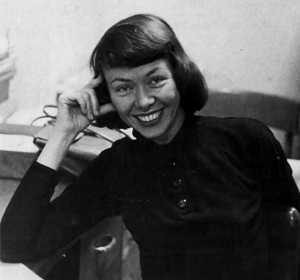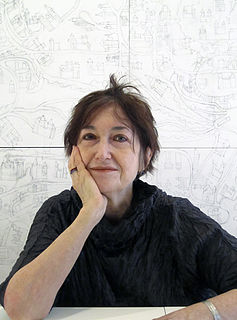Related Research Articles
Mary Frank is an English visual artist who works as a sculptor, painter, printmaker, draftswoman, and illustrator.

Marcia Tucker was an American art historian, art critic and curator. In 1977 she founded the New Museum of Contemporary Art, a museum dedicated to innovative art and artistic practice in New York City, which she ran as the director until 1999.

The feminist art movement in the United States began in the early 1970s and sought to promote the study, creation, understanding and promotion of women's art. First-generation feminist artists include Judy Chicago, Miriam Schapiro, Suzanne Lacy, Judith Bernstein, Sheila de Bretteville, Mary Beth Edelson, Carolee Schneeman, Rachel Rosenthal, and many other women. They were part of the Feminist art movement in the United States in the early 1970s to develop feminist writing and art. The movement spread quickly through museum protests in both New York and Los Angeles, via an early network called W.E.B. that disseminated news of feminist art activities from 1971 to 1973 in a nationally circulated newsletter, and at conferences such as the West Coast Women's Artists Conference held at California Institute of the Arts and the Conference of Women in the Visual Arts, at the Corcoran School of Art in Washington, D.C..
SOHO20 Artists, Inc., known as SOHO20 Gallery, was founded in 1973 by a group of women artists intent on achieving professional excellence in an industry where there was a gross lack of opportunities for women to succeed. SOHO20 was one of the first galleries in Manhattan to showcase the work of an all-woman membership and most of the members joined the organization as emerging artists. These artists were provided with exhibition opportunities that they could not find elsewhere.
Joan Snyder is an American painter from New York. She is a MacArthur Fellow, a Guggenheim Fellow, and a National Endowment for the Arts Fellow (1974).
Mary Kelly is an American conceptual artist, feminist, educator, and writer.

May Stevens was an American feminist artist, political activist, educator, and writer.
Harmony Hammond is an American artist, activist, curator, and writer. She was a prominent figure in the founding of the feminist art movement in 1970's New York.

Joyce Kozloff is an American artist whose politically engaged work has been based on cartography since the early 1990s.
The Women's Caucus for Art (WCA), founded in 1972, is a non-profit organization based in New York City, which supports women artists, art historians, students, educators, and museum professionals. The WCA holds exhibitions and conferences to promote women artists and their works and recognizes the talents of artists through their annual Lifetime Achievement Award. Since 1975 it has been a United Nations-affiliated non-governmental organization (NGO), which has broadened its influence beyond the United States. Within the WCA are several special interest causes including the Women of Color caucus, Eco-Art Caucus, Jewish Women Artist Network, International Caucus and the Young Women's Caucus. The founding of the WCA is seen as a "great stride" in the feminist art movement.
"Where We At" Black Women Artists, Inc. (WWA) was a collective of Black women artists affiliated with the Black Arts Movement of the 1960s and 1970s. It included artists such as Dindga McCannon, Kay Brown, Faith Ringgold, Carol Blank, Jerri Crooks, Charlotte Kâ (Richardson), and Gylbert Coker. Where We At was formed in the spring of 1971, in the wake of an exhibition of the same name organized by 14 Black women artists at the Acts of Art Gallery in Greenwich Village. Themes such as the unity of the Black family, Black female independence and embodiment, Black male-female relationships, contemporary social conditions, and African traditions were central to the work of the WWA artists. The group was intended to serve as a source of empowerment for African-American women, providing a means for them to control their self-representation and to explore issues of Black women's sensibility and aesthetics. Like AfriCobra, a Chicago-based Black Arts group, the WWA was active in fostering art within the African-American community and using it as a tool of awareness and liberation. The group organized workshops in schools, jails and prisons, hospitals, and cultural centers, as well as art classes for youth in their communities.
Mary Beth Edelson was an American artist and pioneer of the feminist art movement, deemed one of the notable "first-generation feminist artists." Edelson was a printmaker, book artist, collage artist, painter, photographer, performance artist, and author. Her works have been shown at the Museum of Modern Art, the Smithsonian American Art Museum, and the Museum of Contemporary Art in Chicago.

Mary Miss is an American artist and designer. Her work has crossed boundaries between architecture, landscape architecture, engineering and urban design. Her installations are collaborative in nature: she has worked with scientists, historians, designers, and public administrators. She is primarily interested in how to engage the public in decoding their surrounding environment.
Martha Nilsson Edelheit, also known as Martha Ross Edelheit, is an American-born artist currently living in Sweden. She is known for her feminist art of the 1960s and 1970s, which focuses on erotic nudes.
Vernita Nemec, also known by the performance name Vernita N'Cognita, is a visual and performance artist, curator, and arts activist based in New York City. She earned her BFA at Ohio University in 1964 and has resided in New York City since 1965. She is also known for her soft stuffed sculpture, collages, artist's books, photographs, and installations. Nemec adopted the pseudonym "N'Cognita," a pun on incognito, as a way to honor artists who have not become well-known.
Eunice Golden is an American feminist painter from New York City, known for exploring sexuality using the male nude. Her work has been shown at the Whitney Museum of American Art, Brooklyn Museum, Bronx Museum of the Arts, Westbeth Gallery, and SOHO20 Gallery.

Marjorie Kramer is a figurative painter of al fresco landscapes and feminist self-portraits.
Ad Hoc Committee of Women Artists or Ad Hoc Women Artists' Committee was founded in 1970 and included members from Women Artists in Revolution (WAR), the Art Workers' Coalition (AWC) and Women Students and Artists for Black Art Liberation (WSABAL). Founding members included Lucy Lippard, Poppy Johnson, Brenda Miller, Faith Ringgold and later, Nancy Spero.

The Women's Interart Center was a New York City–based multidisciplinary arts organization conceived as an artists' collective in 1969 and formally organized in 1970 under the auspices of Women Artists in Revolution (WAR) and Feminists in the Arts. A trailblazing women's alternative space, the Center provided exhibition and performance venues, workshops, and training courses for artists in a wide range of media for over 45 years, with a focus on developing women's skills and fostering innovation. Several prominent visual artists were among the many who exhibited at the Interart Gallery, which in 1976 hosted the first ever festival of black women's film. The Interart Theatre—the Center's off-off-Broadway stage—and its productions won numerous honors.
Jacqueline Skiles is an American artist. She was a member of Women Artists in Revolution (WAR) and participated in the group's demand that the Whitney Museum include more women in its annual exhibitions. She also directed a graphics and silk-screen workshop at the Women's Interart Center.
References
- ↑ A Documentary Herstory of Women Artists in Revolution (2 ed.). Pittsburgh: Know, Inc. 1973.
- 1 2 3 4 5 Broude, Norma; Garrard, Mary D., eds. (1994). The Power of Feminist Art: The American Movement of the 1970s, History and Impact. New York: Harry N. Abrams, Inc. ISBN 0810937328. OCLC 29794506.
- ↑ Rosen, Randy; Brawer, Catherine Coleman (1989). Making Their Mark: Women Artists Move into the Mainstream, 1970-85 (1st ed.). New York: Abbeville Press. ISBN 0896599582. OCLC 18259773.
- ↑ Gardner-Huggett, Joanna (2007). "The Women Artists' Cooperative Space as a Site for Social Change: Artemisia Gallery, Chicago (1973—1979)". Social Justice. 34 (1): 29. JSTOR 29768420.
- ↑ Lubell, Ellen (Summer 1976). "SoHo 20". Womanart. 1 (1): 16.